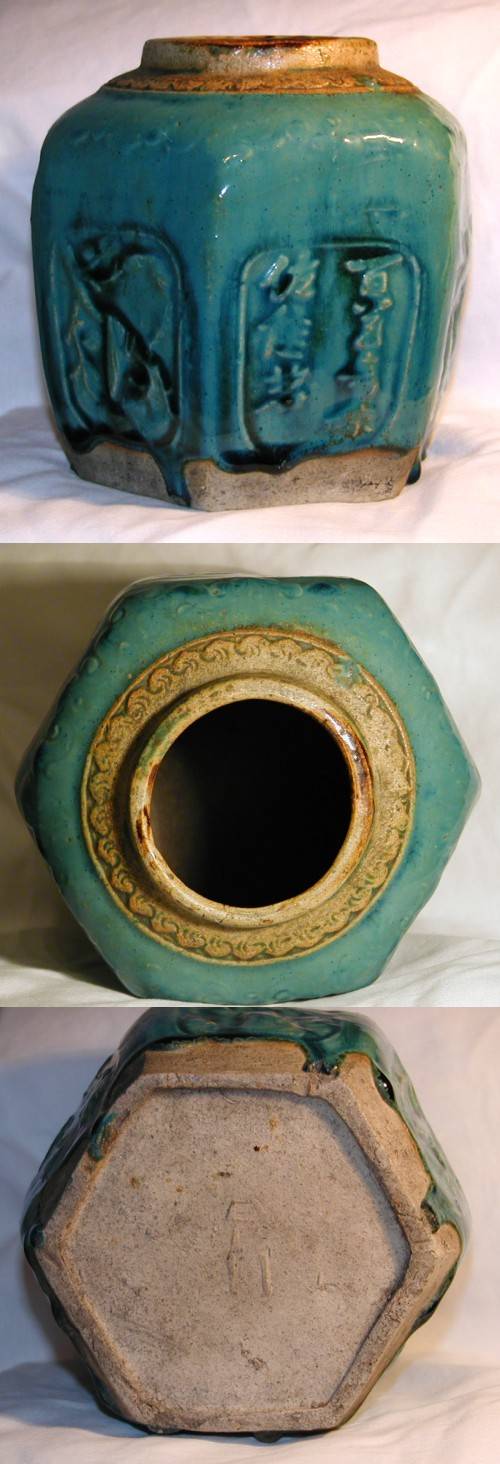
This page is only one of many thousands of Gotheborg.com Help and Information Pages, offering specialized knowledge on Chinese and Japanese Porcelain, including a Glossary, Q&A, Chinese and Japanese Porcelain Marks, Chinese Porcelain Exhibition and Excavation reports etc. For personal help and far more information, join our Discussion Board or use 'Ask a Question' for quick email consultations. For full text and better navigation, use a full-screen device rather than a mobile phone, that offers only limited content.

Dear Sir,
I have been unable to find any information on the net regarding this piece of Chinese pottery.
I acquired it in England in 1978. The woman I bought it from was in her early 70s and told me that her father, a British military officer brought it to her from China as a gift when she was a little girl.
Recently, I showed it to a professor from China who is teaching in this country at a nearby University. He was astounded and believes it to be an artifact at least 700 to 800 years old. He told me that the Chinese inscription on the piece is ancient Chinese and he was unable to decipher some of it. He believes it may be from the Yuan Dynasty or older.
The height of the piece is 6 inches, widest part of piece around 17 1/4 inches and base is 15 inches. It weighs approximately 1.5 pounds. I had to weigh it on a regular bathroom scale so I'm not too sure how accurate this is. With this information can you identify this piece as I am anxious to know something about it.
It is quite beautiful and in excellent condition. Attached are six photos of my pottery piece.
Thanking you in advance for your time.
Dear Sir,
I can clearly understand the professor's enthusiasm. There are many older pottery wares that might be mixed up with this. To find any similar looking jars - of porcelaneous ware and with mold stamped paneled decoration and green glaze - and old enough, we might need to look at the so called Longquan Celadon ware. It was made in the Zhejiang province during the Yuan (1271-1368) dynasty. It might sound similar from a description, but when compared it is clearly a different ware.
This kind of jars are more of a household or gift jar. Jars like this have been made in the South of China well into the 20th century. They are quite hard to date more precisely since they are made in a generally old "Mingish" style. Most of them I would suggest comes from a kiln area immediately outside Canton in the Guangdong province of China, called Shekwan or Shiwan.
Very similar jars are sometimes found with a neatly impressed "Hong Kong" mark on their bases, which simplifies dating.
So, however much I would have loved to confirm an earlier date, I can't do that. From my experience of the shape, look, appearance of the glaze and the top border of your jar, I would need to suggest a late 19th century date as the most likely.
By the end of the 19th cnetury one of the used for this type of jar was for burial gift purposes. The custom was that two were buried along with the casket, one contained water and the other rice.
Thank you for your interest.
Best regards,
Jan-Erik Nilsson
The information of the use of these jars as burial gifts is submitted by David Sablan Comacho to the Gotheborg Board on discussing this type of jars. His comment were; (This is a) Shekwan burial jar as stated earlier probably late 19th century. I use to wander through an old graveyard on Cheung Chau Island, in Hong Kong and pick them up by the dozens off the ground when they dug in it to "replant" someone. As I was told, two were buried with a casket, one contained water and the other rice. .